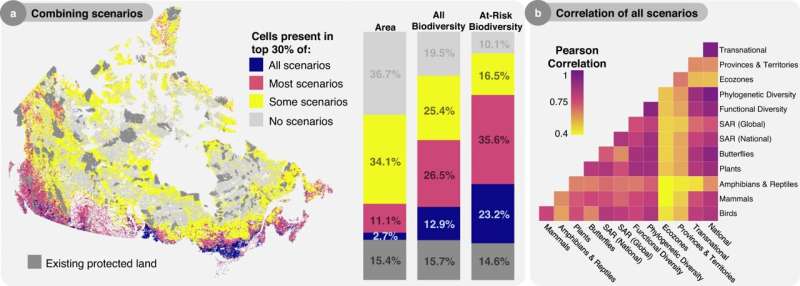This article has been reviewed according to Science X's editorial process and policies. Editors have highlighted the following attributes while ensuring the content's credibility:
fact-checked
peer-reviewed publication
trusted source
proofread
Q&A: How can Canada best meet its commitment to protecting 30% of its land by 2030?

At last year's COP15 conference in Montreal, the Government of Canada set the goal of conserving 30 percent of the country's land and water by 2030. In a new study published in Nature Communications, a group of McGill University researchers have sought to understand how well our existing protected lands preserve Canadian species, how many species we could save if we reach our 30 x 30 targets, and what factors impact our ability to safeguard species in future conserved areas.
Lead author Isaac Eckert, a McGill Ph.D. candidate in Biology, answered some questions about his research.
This interview has been edited and condensed for clarity.
What did you find?
We found that existing protected lands in Canada do not protect Canadian species very well. In fact, only around 15% of Canada's vertebrates, plants, and butterflies are represented by existing protected areas such as National and Provincial parks. The good news is that if we secure the 30% of Canada's land most important to biodiversity, we could protect over 65% of all species. However, our ability to achieve this relies on how we coordinate protection across Canada.
While a national strategy, where the land most important for biodiversity is prioritized for protection, can generate these big conservation gains, regional strategies, where each Province and Territory protects 30% of land, or we protect 30% of each Ecozone, greatly hinder our ability to capture biodiversity in future protected lands. In fact, we lose out on the ability to protect a quarter of all Canada's biodiversity when we spread future protected areas evenly across Canada. This amounts to over 1,000 species.
How can we best protect biodiversity in Canada?
These results suggest that the key to maximizing our ability to protect biodiversity into the future depends on how we as a nation work together to establish new protected areas that prioritize Canada's rich biodiversity. Our results provide a new understanding of the importance of conservation planning across spatial scales and highlight both the challenges and rewards of collaborating to help protect biodiversity into the future.
Why are these findings important for future conservation efforts?
These findings have the potential to shape the conservation strategies of nations around the world. Our main message is on the importance of national strategies, informed by biodiversity science, to establish new protected areas. National strategies to conservation have many benefits, including optimizing the protection of biodiversity, unifying regional actors under a common goal, identifying cross-jurisdictional synergies such as large-scale conservation corridors like Yellowstone to Yukon, and streamlining the tracking and reporting process to reach international targets.
As nations start on their path to reaching 30 x 30, understanding the trade-offs of different approaches to conservation is critical for the protection of biodiversity and potentially the future of life on Earth.
More information: Isaac Eckert et al, 30×30 biodiversity gains rely on national coordination, Nature Communications (2023). DOI: 10.1038/s41467-023-42737-x
Journal information: Nature Communications
Provided by McGill University




















